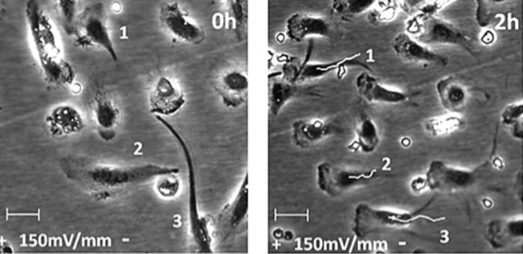Electrical fields aid wound healing
June 10, 2016

Human macrophages migrating directionally toward an electrode. Left: no electric field. Right: Time-lapse photo two hours after 150 mV/mm electric field applied (white lines shows the movement path toward candida yeast; numbers indicate start and end positions of cells). (credit: Joseph I. Hoare et al./JLB)
Small electrical currents appear to activate certain immune cells to jumpstart or speed wound healing and reduce infection when there’s a lack of immune cells available, such as with diabetes, University of Aberdeen (U.K.) scientists have found.
In a lab experiment, the scientists exposed healing macrophages (white blood cells that eat things that don’t belong), taken from human blood, to electrical fields of strength similar to that generated in injured skin. When the voltage was applied, the macrophages moved in a directed manner to Candida albicans fungus cells (representing damaged skin) to facilitate healing (engulfing and digesting extracellular particles). (This process is called “phagocytosis,” in which macrophages clean the wound site, limit infection, and allow the repair process to proceed.)
The electric fields enhanced the uptake and clearance of a variety of targets known to promote inflammation and impair healing in addition to Candida albicans, including latex beads and expended white blood cells.*
“These findings raise the prospect that EF-based therapies could be extended beyond tissue repair and ultimately, be exploited to modulate the function of macrophages in other inflammatory diseases where these cells are dysregulated,” the researchers note in a report appearing in the June 2016 issue of the Journal of Leukocyte Biology.
“This new work identifies previously unappreciated opportunities to tune immune system function with electrical fields and has potentially wide-reaching implications for wound repair for a variety of diseases where macrophages play a role, including infectious disease, cancer and even obesity,” said John Wherry, Ph.D., Deputy Editor of the Journal of Leukocyte Biology.
The research extends previous research reported by KurzweilAI (New evidence that electrical stimulation accelerates wound healing).
* The experiments also showed that electric fields selectively augmented the production of protein modulators associated with the healing process, enhancing cytokine (growth factor) production and phagocytic activity essential for clearance of infection and for tissue repair and confirming that macrophages are tuned to respond to naturally generated electrical signals in a manner that boosts their healing ability.
Abstract of Electric fields are novel determinants of human macrophage functions
Macrophages are key cells in inflammation and repair, and their activity requires close regulation. The characterization of cues coordinating macrophage function has focused on biologic and soluble mediators, with little known about their responses to physical stimuli, such as the electrical fields that are generated naturally in injured tissue and which accelerate wound healing. To address this gap in understanding, we tested how properties of human monocyte-derived macrophages are regulated by applied electrical fields, similar in strengths to those established naturally. With the use of live-cell video microscopy, we show that macrophage migration is directed anodally by electrical fields as low as 5 mV/mm and is electrical field strength dependent, with effects peaking ∼300 mV/mm. Monocytes, as macrophage precursors, migrate in the opposite, cathodal direction. Strikingly, we show for the first time that electrical fields significantly enhance macrophage phagocytic uptake of a variety of targets, including carboxylate beads, apoptotic neutrophils, and the nominal opportunist pathogen Candida albicans, which engage different classes of surface receptors. These electrical field-induced functional changes are accompanied by clustering of phagocytic receptors, enhanced PI3K and ERK activation, mobilization of intracellular calcium, and actin polarization. Electrical fields also modulate cytokine production selectively and can augment some effects of conventional polarizing stimuli on cytokine secretion. Taken together, electrical signals have been identified as major contributors to the coordination and regulation of important human macrophage functions, including those essential for microbial clearance and healing. Our results open up a new area of research into effects of naturally occurring and clinically applied electrical fields in conditions where macrophage activity is critical.